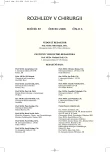Surgical Site Infection Following Proximal GIT Procedures
Authors:
F. Vyhnánek; V. Ducháč; P. Skála; V. Teplan jr.
Authors‘ workplace:
Chirurgická klinika 3. LF UK a FNKV Praha
Published in:
Rozhl. Chir., 2008, roč. 87, č. 6, s. 297-300.
Category:
Monothematic special - Original
Overview
Introduction:
Surgical site infections (ICHM) remain a serious problem in the proximal GIT surgery, with incidence rates from 5% to 26% in planned procedures, and up to 40% in urgent procedures. Surgical site infections result in increased postooperative morbidity and mortality rates, prolonged hospitalization and increased treatment costs. Minimalization of the surgical site infection rates is an important epidemiological and therapeutical objective.
Aim:
A retrospective study assessed surgical site infections rates in urgent and elective procedures on the proximal GIT, and in a selected group of elective procedures on the large intestine and rectum. The significance of some risk factors was assessed based on analyses of surgical site infections in all subjects operated during the two-year study period.
Patients and Methods:
Infection rates following urgent procedures were analysed in 545 subjects operated for acute abdomen during 2003–2004. In another study group of 4667 subjects operated during 2005–2006, surgical site infection rates were analysed based on assessment of some risk factors. In this group, incidence of surgical site infections in 640 patients following proximal GIT procedures was studied. In a selected group of 192 elective colorectal procedures, incidence rates of surgical site infections and peritoneal infections were evaluated.
Results:
Surgical site infections occurred in 71 (13 %) of the subjects in the group of 545 patients operated for acute abdomen. In 48 patients, the microbiological findings in surgical site infections were positive with the following commonest pathogens: Escherichia coli, staphylococci and Enteroccocus faecalis. Surgical site infections were demonstrated in 217 subjects (4.6%) out of the total of 4667 patients included in the study group. The surgical site infections risk factors, which were found statistically significant (p < 0.05), included the procedure’s duration over 2 hours (p = 0.042) and the age > 50 (p = 0.047). Surgical site infections occurred most frequently in the group of 640 subjects with proximal GIT procedures, classified as septic procedures (surgical site infections in 28.5% and in the peritenal cavity in 8%). In the group of 192 subjects with colorectal procedures, the surgical site infections occurred in 6.8%, peritoneal cavity infections in 3.1% of the subjects.
Conclusion:
Surgical site infections are the commonest postoperative infections in proximal GIT surgeries. The surgical site is the commonest location. The principal pathogens following urgent procedures include Enterobacteriacae, enterococci and staphylococci. The following risk factors were found statistically significant: the procedure’s duration (> 2 hours) and the patient’s age (< 50 years).
Key words:
surgical site infections – proximal GIT procedures/surgery– risk factors
Sources
1. Blumetti, J., Luu, M., Zarosí, G., et al. Surgical site infections after colorectal surgery: Do risk factors depending on the type of infection considered? Surgery, 2007, roč. 142, č. 5, s. 704–711.
2. Fa-Si-Oen, P. R., Kroeze, F., Verhoef, L. H. M., et al. Bakteriology of abdominal wounds in elective open colon surgery: a prospective study of 100 surgical wounds. Clin. Microbiol. Infect., 2005, roč. 11, č. 2, s. 155–157.
3. Tang, R., Chen, H. H., Wang, Y. L., et al. Risk factors for surgical site infection after elective resection of colon and rectum: a single-center prospective study of 2,809 consecutive patiens. Ann. Surg., 2001, roč. 234, č. 2, s. 181–189.
4. Itani, K. M. F., Wilson, S. E., Awad, S. S. Ertapenem versus cefotetan prophylaxis in elective colorectal surgery. N. Engl. J. Med., 2006, roč. 355, č. 25, s. 2640-2651.
5. Moine, P., Asehnoune, K., Spievack, A. R., et al. Antibiotic prophylaxis in colorectal surgery. N. Engl. J. Med., 2007, roč. 356, č. 16, s. 1684–1685.
6. Fujita, S., Saito, N., Yamada, T., et al. Randomized, multicenter trial of antibiotic prophylaxis in elective colorectal surgery: single dose vs 3 dose of a second-generation cephalosporin without metronidazole and oral antibiotics. Arch. Surg., 2007, roč. 142, č.7, s. 657–661.
7. Jung, B., PĆhlman, L., Nystrom, P. O., et al. Multicentre randomized clinical trial of mechanical bowel preparation in elective colonic resection. Br. J. Surg., 2007, roč. 94, č. 6, s. 689–695.
8. de Oliveira, A. C., Ciosak, S. I., Ferraz, E. M., et al. Surgical site infection in patiens submitted to digestive surgery: risk prediction and the NNIS risk index. Am. J. Infect. Control., 2006, roč. 34, č.4, s. 201–207.
9. Barie, S. Ph., Eachempati, S. R. Surgical site infections. Surg. Clin. N. Am., 2005, roč. 85, č. 6, s. 1115–11135.
10. Konishi, T., Watanabe, T., Kishimoto, J., et al. Elective colon and rectal surgery differ in risk factors for wound infection: results of prospective surveillance. Ann. Surg., 2006, roč. 244, č. 5, s. 758–763.
11. Walz, J. M., Paterson, C. A., Seligowski, J. M., et al. Surgical site infection following bowel surgery : a retrospective analysis of 1446 patients. Arch. Surg., 2006, roč. 141, č. 10, s. 1014–1018.
12. Belda, F. J., Aguilera, L., Garcia de la Asunción, J., et al. Supplemental perioperative oxygen and the risk of surgical wound infection: a randomized controlled trial. JAMA, 2005, roč. 294, č. 16, s. 2035–2042.
Labels
Surgery Orthopaedics Trauma surgeryArticle was published in
Perspectives in Surgery

2008 Issue 6
- Metamizole vs. Tramadol in Postoperative Analgesia
- Metamizole at a Glance and in Practice – Effective Non-Opioid Analgesic for All Ages
- Current Insights into the Antispasmodic and Analgesic Effects of Metamizole on the Gastrointestinal Tract
Most read in this issue
- Short Bowel Syndrome and Limits of Small Intestinal Resections
- Cystic Feochromocytoma, Mimicing a Liver Cyst. A Case Review
- Ventral Hernia Associated with Morbid Obesity – When Is Surgery Indicated?
- Miniinvasive Surgery in Spontaneous Pneumothorax – Indications and Surgical Technique
